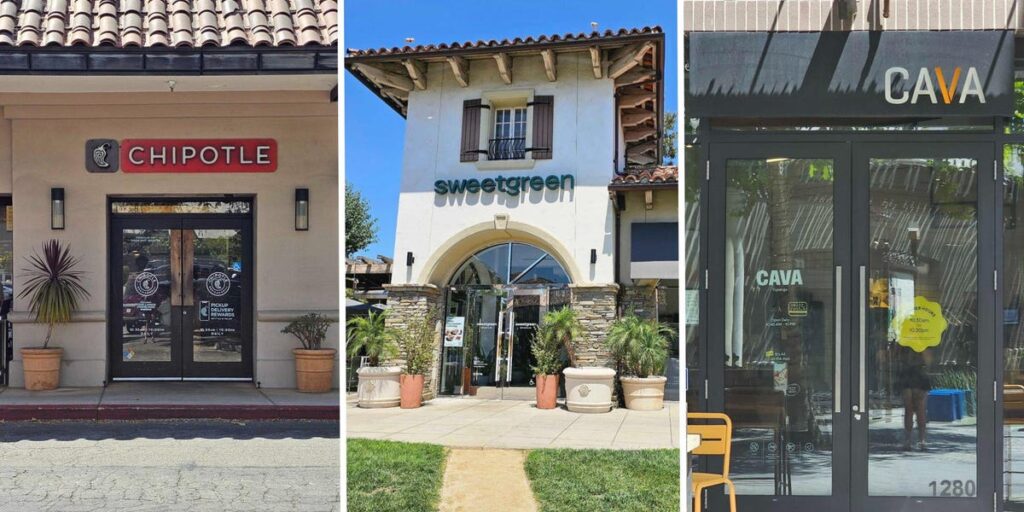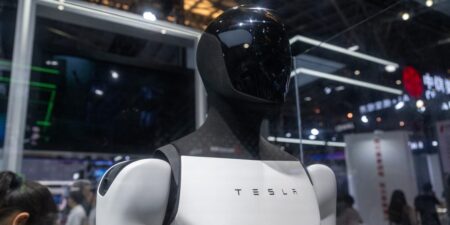It appears the era of the “slop bowl” may be fading.
Fast-casual restaurants like Chipotle, Sweetgreen, and Cava had been exceptions to the restaurant industry’s slumping sales and diminished foot traffic as consumers curbed their spending over the better part of the last year.
Those days seem to be over: $20 can now get you table service with your Triple Dipper at Chili’s, and other casual and fast-food chains are ramping up their combo meal offerings. Doesn’t that muck up the slop bowl’s value proposition? Consumers seem to think so.
Sweetgreen’s same-store sales fell 7.6% in the second quarter, while Chipotle reported a 4% decline — one of the brand’s worst quarters since 2020. Cava, while expanding locations, also reported a slowdown in same-store sales: 2.1% growth in its most recent quarter, a significant deceleration from the 14.4% growth it enjoyed in the prior-year quarter.
“If I’m going to spend an extra $4 or $5 to go to Chipotle or Cava versus McDonald’s, that value still needs to be there — it just needs to be a different type of value,” Jean-Pierre Lacroix, president of the brand strategy firm SLD, told Business Insider. “They need to find that balance and provide value while creating something unique that is memorable and shareable.”
Four analysts and brand strategists who spoke to Business Insider said each restaurant is grappling with its value proposition. Gone are the days when consumers would frivolously swing for a larger-sized soda or an added side. Customers demand filling meals, healthy options, and affordable prices, with slop bowls no longer seen as the top dog in those categories.
That raises the question: do the bowls themselves live up to the value promise that made each brand popular? I tried each chain to find out.
Chipotle was the most filling — and least expensive
At $19.01 for a burrito bowl, chips, and a drink, Chipotle was the most economical option — and the most filling of the three chains I tried. I sampled the recently re-released carne asada bowl, now available for a limited time, and found it flavorful and fresh. The hearty portion size (with over 1,000 calories if you add guacamole) easily stretched to feed me for both lunch and dinner.
Laurie Schalow, Chipotle’s chief corporate affairs officer, told Business Insider that the brand’s prices remain 20% to 30% less than meals at other fast-casual chains and often below comparable meals at many quick-service restaurants.
“The health of the Chipotle brand remains very strong,” Schalow said, citing customer perception surveys measuring satisfaction with the company’s offerings.
Cava’s flavors and colors were exciting — but pricey
I hadn’t eaten at Cava before. I spent $28.97 on a bowl, spicy pita chips, a drink, and a blondie bite — an impulsive $2.95 purchase my sweet tooth made me indulge in at the register.
With around 600 calories for the bowl and a nearly $30 price point, I wouldn’t spend that much on lunch on a regular basis.
That said, Mediterranean flavors are some of my favorites, and this steak and harissa bowl didn’t disappoint. Not only was it delicious, but the bowl was presented beautifully, with the colors of cabbage, cucumber, and tomato worthy of a second glance.
Instead of focusing on a traditional value proposition like a combo deal, Cava’s CEO Brad Schulman said during the brand’s Q2 earnings call that its popular hot harissa meal — which included a promotional stuffed pita chip toy — was intended to “tap into the emotional connection of our guests.”
The brand’s internal surveys of customers indicate they see the meals as a good value, Schulman said.
A spokesperson for Cava declined to comment for this story.
Sweetgreen was tasty — but the weakest link
With all due respect to Sweetgreen and its fan base, $29.01 for a salad, a slice of focaccia, and a drink was simply too rich for my blood.
In fairness, I tried to keep each meal comparable by sampling the same protein offering at each chain, so my steak substitution added about $3 to the typical price point. But even if I’d opted for the chicken that comes standard with the harvest bowl, I’m not sure I’d have had a different takeaway.
While it tasted fine, the Sweetgreen salad was largely comprised of kale. At 740 calories, it was more nutritionally dense than the Cava bowl, but it was somewhat less flavorful and satisfying than its competitors.
On my first visit to Sweetgreen, I ate midday in an affluent Los Angeles suburb. Upon finding my seat, I texted my editor that the meal was “yuppie food” — with trendy flavor profiles, Instagrammable decor, and a high price point that felt clearly geared toward the young urban professionals who filled the dining area. I love a good salad, but as a frugal spender, I didn’t feel like the target consumer.
Sweetgreen has recognized an issue with its value proposition. CEO Jonathan Neiman said during the company’s August earnings call that it would increase its chicken and tofu portions by 25% to appeal to value-conscious customers.
Since I got steak in mine, I’m not sure such an increase would have mattered much to me. The analysts who spoke to Business Insider said that leaning toward bigger portions is a risky move because customers could be irritated if Sweetgreen ever reverses the decision.
Representatives for Sweetgreen did not immediately respond to a request for comment from Business Insider.
There’s nothing wrong with the food, but slop bowls are a messy business
Each of the meals I sampled was worth a second bite. The bowls were fresh, their offerings solid, and — if someone else were picking up the tab — I’d happily enjoy a meal at any of these locations again.
Truly, there wasn’t anything wrong with the food. Still, the analysts I spoke to had a point: there’s a bigger issue at play here than a single chain’s strategy. The meals deliver, but the math doesn’t.
“Those companies, none of them did anything wrong. Most of us would love to be that successful,” Gregg Majewski, founder and CEO of the restaurant group Craveworthy Brands, told Business Insider. “It’s that the economy’s finally gotten to a point where even the big boys and the ones that are the market leaders are starting to feel the pressures that everybody else has been facing.”
For fast-casual chains like Cava, Chipotle, and Sweetgreen, it’s clear the slop bowls still slap — what’s not obvious is whether that’ll be enough to save the bottom line.
Read the full article here
















